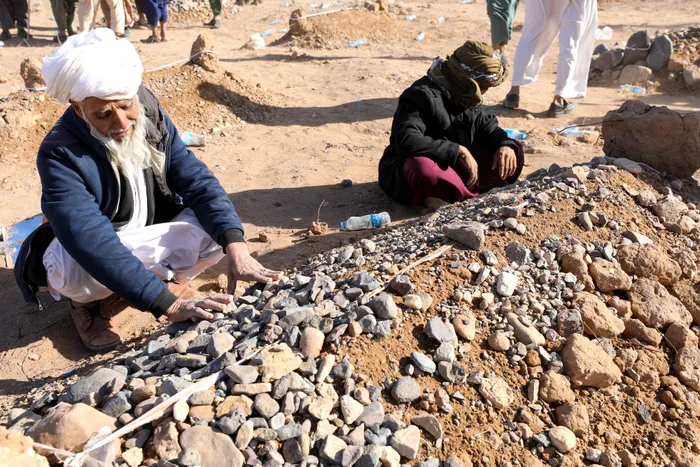LOOK: Mass funeral held for Afghanistan quake victims, families still missing

Afghan mourners sit beside a grave after funeral prayers for their relative's body from the earthquakes in Sarbuland village, Zendeh Jan district of Herat province, on October 8, 2023. The death toll from a series of earthquakes in western Afghanistan rose sharply again on October 8 to more than 2,000, with nearly 10,000 injured, as rescue workers dug through razed villages for vanishing signs of life. Picture: Mohsen Karimi/AFP
Siah Ab, Afghanistan - A mass funeral ceremony for around 300 earthquake victims was held Monday in rural western Afghanistan, as families remained trapped in the rubble of their ruined homes two days after high-magnitude tremors killed more than 2,000 people.
In Siah Ab village, near the epicentre of Saturday's magnitude 6.3 quake followed by eight aftershocks, white-shrouded bodies were unloaded from a fleet of ambulances and laid in ranks as crowds solemnly crossed their arms in Islamic prayer.
"I thought I must have been dreaming, all the places were razed," said 30-year-old Ismail, who goes by only one name. "No one is left."
In nearby Nayeb Rafi - once home to about 2,000 families - there were no buildings left standing, only undulating piles of broken mud bricks which were once ceilings and walls.
Twin excavators scooped at the wreckage to retrieve belongings and bodies as hopes of finding survivors died out in some areas. Elsewhere, those still optimistic continued to dig with spades and pickaxes.
"There are families who don't have anyone left alive," said 50-year-old Ali Mohammad. "No one is left, not a woman nor a child, no one."
"One family had twenty members buried in the rubble," he said, adding that only two members of the family survived because they happened to be out of the home.
The UN says "100 percent" of homes were destroyed in 11 villages of rural Zenda Jan district, around 30 kilometres (19 miles) north-west of Herat city, capital of the same-named province.
'Families in debris'
Disaster management ministry spokesman Mullah Janan Sayeq said that still "people are trying to search and get their family out of debris".

Reports from the field described "a very bad situation" he told a news conference in the capital.
Local and national officials gave conflicting counts of the number of dead and injured, but the disaster ministry said Sunday that 2,053 people had died.
"We can't give exact numbers for dead and wounded as it is in flux," Sayeq said Monday.
The World Health Organisation estimated more than 11,000 people had been affected from 1,655 families.
Aid trickled in Monday on trucks packed with food and blankets, and blue tents began to pop up among the ruins.

As winter draws in, providing shelter for residents will be a major challenge for Afghanistan's Taliban government, which seized power in August 2021 and has fractious relations with international aid organisations.
'Crisis on top of crisis'
Taliban authorities have banned women from working for UN and non-governmental organisations (NGOs) in the country, making it difficult to assess family needs in deeply conservative parts of the country.
Amnesty International said the Taliban government should "ensure that rescue and relief efforts are carried out without discrimination" and "guarantee safe and unrestricted access to the affected regions for humanitarian agencies".
"It is critical that all assistance meets the needs of the most at-risk groups who often face compounded challenges in crisis situations, including women, children, older persons, and people with disabilities," said South Asia regional researcher Zaman Sultani.
Most rural homes in Afghanistan are made of mud, built around wooden support poles, with little in the way of modern steel reinforcement.
Multi-generational extended families generally live under the same roof, meaning disasters such as Saturday's quake can devastate local communities.
Afghanistan is already suffering a dire humanitarian crisis, with the widespread withdrawal of foreign aid following the Taliban's return to power.
Save the Children called the quake "a crisis on top of a crisis".
"The scale of the damage is horrific. The numbers affected by this tragedy are truly disturbing," said the group's country director Arshad Malik.
Herat province - home to around 1.9 million people on the border with Iran - has also been hit by a years-long drought that has crippled many hardscrabble farm communities.
Afghanistan is frequently hit by earthquakes, especially in the Hindu Kush mountain range, which lies near the junction of the Eurasian and Indian tectonic plates.
More than 1,000 people were killed and tens of thousands left homeless last June after a 5.9-magnitude quake struck the impoverished province of Paktika.
AFP